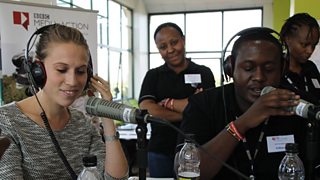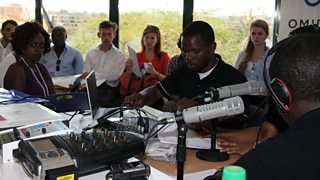Communication is life!
Joyce Nyaboga
Humanitarian Lead for Βι¶ΉΤΌΕΔ Media Action in Kenya and Somalia
Tagged with:
When I worked at Dadaab Refugee camp in northern Kenya, I saw how refugees would day in, day out tune into the Βι¶ΉΤΌΕΔ Somali Service and crowd around our agency information board to find out the latest news.Β Communication, it was obvious, is life!Β Β
This was forefront in my mind last week in Nairobi when the Βι¶ΉΤΌΕΔ Media Action team and I took part in the launch of the annual by the International Federation of Red Cross and Red Crescent Societies.Β
This year, the report examines the profound impact of technological innovations on humanitarian action. We were at the event to show how media and humanitarian responders can work jointly together – the aim of our current project in Kenya.Β
Our key message to those attending the event was how important it is to create two-way communications - and we developed an interactive demonstration to show how to do it.

A hands-on demo
We came up with a scenario: a disastrous flood had hit the Nyando region in Kenya, an area perennially affected by flooding.
The media and humanitarian staff at the launch were then set the task of creating a mini radio station and airing a live lifeline programme.
The participants were at first a little daunted. But with our team’s help, they succeeded in creating a programme that provided practical information to affected communities, such as where food aid was available and how people could avoid water-borne diseases and trace displaced family members.
The programme also interviewed a woman affected by the flooding – played by an actress – who told how her son was missing since the floods and her younger daughter was in hospital with cholera.
Effective communication in a crisis
We showed how to communicate with affected communities during a crisis – and the important ways in which Lifeline programming differs from day to day journalism: it is for affected people and not about them, as such every second of airtime must offer something that will in some way help them cope with or improve their situation.
Participants learned how to handle interviews sensitively with people affected by a disaster and we emphasised the importance of investing in portable equipment which can be used during a humanitarian crisis when infrastructure may be destroyed.Β
But our key message was how important it is to place affected people at the forefront of such lifeline programming.Β Many of the participants acknowledged that all too often emergency responses through the media are purely one-way and that local media sources need support to do better two-way communication.Β
So we ensured that the participants knew how important it was to incorporate the voices of affectedΒ people into the programme, so they can share their experience, express their needs and concerns, ask questions and have space to hold relief providers to account.
We also showed participants how to provide contact details to enable people to get in touch with the programme makers at a later date and interact with the output. We emphasised that this was key!Β

Importance of listening
We were thrilled at the response. "The work that Βι¶ΉΤΌΕΔ Media Action is doing with disaster-affected communities is nothing short of excellent. I am impressed with the presentation, the radio simulation that you put together and the special lifeline programme," Rocco Nuri from the UNHCR Innovation team in Nairobi told me.
We were also careful to listen to the participants' input about how we could make lifeline programming more responsive and learned how strongly people felt that both media and humanitarian agencies should work closely together in humanitarian crises.
For example, the findings from Joint Needs Assessment processes (in which agencies gather information about the needs of disaster-affected communities) will help us develop programme content that is well-tailored to our audiences, in the same way that it helps other relief providers define what kind of aid they should to supply to whom.
The most important thing I learned was that we must listen, work with other actors in the field and remain in tune with the changing ways in which humanitarian support is delivered.
Related links
Follow Βι¶ΉΤΌΕΔ Media Action on and
